france
 When the colonists left England to form America, they were like the younger sibling, at least when it came to language and much of how they ran the country. Nevertheless, like that younger sibling, things began to change pretty quickly. Part of the change was due simply to distance. When you don’t hear a language all the time, you begin to vary in your own speech. I didn’t really realize there was such a difference between American English and British English, other than the accent of course. Still, I noticed that more and more forms were asking which of the two I spoke. I always thought that it was an odd question, because English is English…right? Well, the correct answer is…wrong!! And when I thought about it, I knew that to be true.
When the colonists left England to form America, they were like the younger sibling, at least when it came to language and much of how they ran the country. Nevertheless, like that younger sibling, things began to change pretty quickly. Part of the change was due simply to distance. When you don’t hear a language all the time, you begin to vary in your own speech. I didn’t really realize there was such a difference between American English and British English, other than the accent of course. Still, I noticed that more and more forms were asking which of the two I spoke. I always thought that it was an odd question, because English is English…right? Well, the correct answer is…wrong!! And when I thought about it, I knew that to be true.
The changes began almost immediately after the first Englishman set foot on American soil. It all started with “Americanisms.” These “Americanisms” have been created or changed from other English terms to produce a language that differs from our forefathers, signifying our uniqueness and independence. I’m sure our founders were rather pleased with themselves with this process, if they realized it at all. By the time of the first United States census, in 1790, there were four million Americans, 90% of whom were descendants of English colonists. When I think of the speed of that growth, it strikes me as phenomenal to say the least. Because of the large English background, there was no question that our official native language would be “English,” but it would not be the same as that spoken in Great Britain. “Americanism” means a word or expression that originated in the United States. The term includes outright coinages and foreign borrowings which first became “English” in the United States, as well as older terms used in new senses first given them in American usage.
In fact, by 1720, the colonists knew that we did not speak the same language as the people in England. The most obvious reason was, of course, the sheer distance from England. Nevertheless, that was not the only  reason. Over the years, many words were borrowed from the Native Americans, as well as other immigrants from France, Germany, Spain, and other countries. We had to communicate with the people around us too, and other words that became obsolete “across the pond,” continued to be utilized in the colonies. In other cases, words simply had to be created in order to explain the unfamiliar landscape, weather, animals, plants, and living conditions that these early pioneers encountered. These things might not have existed in England.
reason. Over the years, many words were borrowed from the Native Americans, as well as other immigrants from France, Germany, Spain, and other countries. We had to communicate with the people around us too, and other words that became obsolete “across the pond,” continued to be utilized in the colonies. In other cases, words simply had to be created in order to explain the unfamiliar landscape, weather, animals, plants, and living conditions that these early pioneers encountered. These things might not have existed in England.
By 1756, the English would make the first “official” reference to the “American dialect.” Samuel Johnson made note of it a year after he published his Dictionary of the English Language. Johnson’s use of the term “American dialect” was not meant to simply explain the differences, but rather, was intended as an insult. It was rather like calling our language the “low class” version of the English language. Remember if you will, that there were those who did not think the United States should ever be a sovereign nation. Years earlier…as early as 1735, the English were calling our language “barbarous,” and referred to our “Americanisms” as barbarisms. The English sneered at our language, something that continued for more than a century after the Revolutionary War, as they laughed and condemned as unnecessary, hundreds of American terms and phrases.
Our newly independent Americans, were proud of their “new” American language, wearing it, as a badge of independence. In 1789, Noah Webster wrote in his Dissertations on the English Language: “The reasons for American English being different than English English are simple: As an independent nation, our honor requires us to have a system of our own, in language as well as government.” Our leaders, including Thomas Jefferson and Benjamin Rush, agreed. It was not only good politics, it was sensible. The feelings of the “rest of the world” didn’t matter. The language changed even more during the western movement as Native American and  Spanish words became a part of our language.
Spanish words became a part of our language.
In 1923, the State of Illinois General Assembly, passed the act stating in part: “The official language of the State of Illinois shall be known hereafter as the “American” language and not as the “English” language.” A similar bill was also introduced in the U.S. House of Representatives the same year but died in committee. Now, after centuries of forming our “own” language, the English and American versions are once again beginning to blend as movies, songs, electronics, and global traveling bring the two “languages” closer together once again.
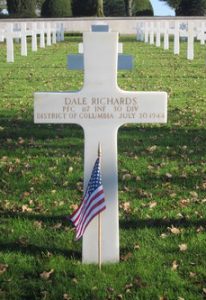 Memorial Day…an often misunderstood day, is actually a day to remember those military men and women who paid the ultimate price for our freedom…they gave their life in service to their country. Whether we know it or not, I’m sure that every family has lost a love one to war…some war in history. It might be many years in the past, and we may not even know about it at all, nevertheless, it is our duty to remember and to honor them, because they sacrificed their very lives that we might live in a free nation. It is so hard to think of someone that we care about, being killed in a foreign country while fighting a war.
Memorial Day…an often misunderstood day, is actually a day to remember those military men and women who paid the ultimate price for our freedom…they gave their life in service to their country. Whether we know it or not, I’m sure that every family has lost a love one to war…some war in history. It might be many years in the past, and we may not even know about it at all, nevertheless, it is our duty to remember and to honor them, because they sacrificed their very lives that we might live in a free nation. It is so hard to think of someone that we care about, being killed in a foreign country while fighting a war.
I am one of those people who doesn’t personally know of a family member lost in a war, but my Uncle Jim Richards brother, Dale was lost on the beaches of Normandy France on July 30, 1944. It is incomprehensible to me to think of his family getting word of his passing, only to find out that they would have to foot the bill to bring him home for burial. There simply were not enough funds, and so Dale was buried at the Brittany American Cemetery and Memorial, in Normandy, France. I can’t begin to imagine the awful day when the summer suddenly seemed as cold as ice. No parent should have to outlive their child, but with war comes death, and someone’s son or daughter will not be coming home again. I heard it put best in a song by Tim McGraw. The song, If you’re Reading This talks about getting a “one way ticket” over there. Unfortunately, far too many of our young men and women have been given that one way ticket, and while they paid with their lives, their families paid too. Their loved one is forever take from them, and they are left to mourn…to try to go on with their lives.
So many people look at Memorial Day as a holiday…a day to hold picnics, sports events and family gatherings. This day is traditionally seen as the start of the summer season for cultural events. For the fashion conscious, it is seen as acceptable to wear white clothing, particularly shoes from Memorial Day until Labor Day. However, fewer and fewer people follow this rule and many wear white clothing throughout the year. But how should we, the living, best honor the lives of all those who have died in service to our country? On Memorial Day, it is traditional to fly the flag of the United States at half staff from dawn until noon. Many people visit cemeteries  and memorials, particularly to honor those who have died in military service. Many volunteers place an American flag on each grave in national cemeteries. in reality, this is a day to reflect on the sacrifices made to keep us free. While we feel like we should be honoring veterans who have passed away, the reality is that their day is Veterans Day, which honors the veterans of all wars living or dead. Within the military, there is a very strict protocol concerning the days we honor military personnel. The other thing that we tend to find odd about Memorial Day, is that we can’t go to someone and thank them for their sacrifice, because the way they came to be honored is to have given their life for their country. All we can do is to honor their memory.
and memorials, particularly to honor those who have died in military service. Many volunteers place an American flag on each grave in national cemeteries. in reality, this is a day to reflect on the sacrifices made to keep us free. While we feel like we should be honoring veterans who have passed away, the reality is that their day is Veterans Day, which honors the veterans of all wars living or dead. Within the military, there is a very strict protocol concerning the days we honor military personnel. The other thing that we tend to find odd about Memorial Day, is that we can’t go to someone and thank them for their sacrifice, because the way they came to be honored is to have given their life for their country. All we can do is to honor their memory.
 Recently, I found out that my family is related to Alvin Cullum York, who was one of the most decorated United States Army soldiers of World War I. York is my 8th cousin once removed on my dad’s side of the family. York received the Medal of Honor for leading an attack on a German machine gun nest, taking 35 machine guns, killing at least 25 enemy soldiers, and capturing 132. York’s Medal of Honor action occurred during the portion of the Meuse-Argonne Offensive in France, which was led by the United States, and was intended to breach the Hindenburg line and force the Germans to surrender.
Recently, I found out that my family is related to Alvin Cullum York, who was one of the most decorated United States Army soldiers of World War I. York is my 8th cousin once removed on my dad’s side of the family. York received the Medal of Honor for leading an attack on a German machine gun nest, taking 35 machine guns, killing at least 25 enemy soldiers, and capturing 132. York’s Medal of Honor action occurred during the portion of the Meuse-Argonne Offensive in France, which was led by the United States, and was intended to breach the Hindenburg line and force the Germans to surrender.
York was born in rural Tennessee on December 13, 1887, the third of eleven children of William and Mary (Brooks) York. His parents farmed, and his father worked as a blacksmith. The York children had minimal schooling because they helped provide for the family, which included hunting, fishing, and hiring out as laborers. After the death of York’s father, he assisted in caring for his younger siblings, and found work as a logger and on construction crews. York wen to church on a regular basis, but he also drank heavily and had a reputation for fistfighting. In 1914 he had a conversion experience, and vowed to improve. He became even more devoted to the Church of Christ in Christian Union.
Upon being drafted into World War I, York initially claimed conscientious objector status on the grounds that his denomination forbade violence. It was because of his internal struggle about whether or not war was the same 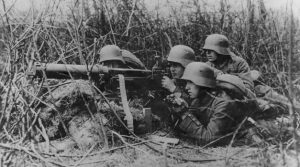 as murder. York prayed about it for the better part of a whole night, before feeling led to proceed with his military assignment. York joined the 82nd Division as an infantry private, and went to France in 1918. He was a part of the group of soldiers know as dough boys. In October 1918, York was promoted to corporal, as one of a group of 17 soldiers assigned to infiltrate German lines and silence a machine gun position. After the American patrol had captured a large group of enemy soldiers, German small arms fire killed six Americans and wounded three. York was the highest ranking of those still able to fight, so he took charge. While his men guarded the prisoners, York attacked the machine gun position, dispatching several German soldiers with his rifle. By the time six Germans charged him with bayonets he was out of rifle ammunition, so he drew his pistol and shot them all. The German officer responsible for the machine gun position had emptied his pistol while firing at York, but missed. This officer then offered to surrender, and York accepted. York and his men marched back to their unit’s command post with more than 130 prisoners. York was immediately promoted to sergeant, and was awarded the Distinguished Service Cross. After further investigation the award was upgraded to the Medal of Honor. York became a national hero and international celebrity. He also received decorations from several foreign countries, including France, Italy, and Montenegro.
as murder. York prayed about it for the better part of a whole night, before feeling led to proceed with his military assignment. York joined the 82nd Division as an infantry private, and went to France in 1918. He was a part of the group of soldiers know as dough boys. In October 1918, York was promoted to corporal, as one of a group of 17 soldiers assigned to infiltrate German lines and silence a machine gun position. After the American patrol had captured a large group of enemy soldiers, German small arms fire killed six Americans and wounded three. York was the highest ranking of those still able to fight, so he took charge. While his men guarded the prisoners, York attacked the machine gun position, dispatching several German soldiers with his rifle. By the time six Germans charged him with bayonets he was out of rifle ammunition, so he drew his pistol and shot them all. The German officer responsible for the machine gun position had emptied his pistol while firing at York, but missed. This officer then offered to surrender, and York accepted. York and his men marched back to their unit’s command post with more than 130 prisoners. York was immediately promoted to sergeant, and was awarded the Distinguished Service Cross. After further investigation the award was upgraded to the Medal of Honor. York became a national hero and international celebrity. He also received decorations from several foreign countries, including France, Italy, and Montenegro.
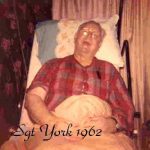
To reward their hero, some businessmen in Tennessee organized the purchase of a farm for York, his new wife, and their growing family. York later formed a charitable foundation to improve educational opportunities for children in rural Tennessee, as a way of giving back o his home state. In the 1930s and 1940s, York worked as a project superintendent for the Civilian Conservation Corps and managed construction of the Byrd Lake reservoir at Cumberland Mountain State Park, after which he served for several years as park superintendent. In his later years, York was confined to bed by health problems. He died in Nashville, Tennessee, on September 2, 1964 and was buried at Wolf River Cemetery in his hometown of Pall Mall.
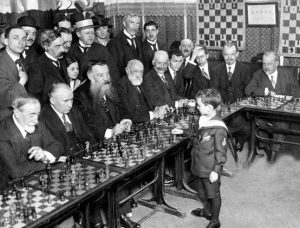 Mastery knows no age. Genius can occur in anyone, and of course, always presents itself when a child is very young. In 1920, one such genius, Samuel Reshevsky was busy mastering chess masters in France. Reshevsky learned chess when he was just 4 years old. He became known as a child chess prodigy and was playing simultaneous games of chess against adults when he was 6 years of age. At age 8 he was playing chess against strong players. Following the events of World War 1, Reshevsky immigrated to the United States. As a 9 year old, his first American simultaneous exhibition was with 20 officers and cadets at the Military Academy at West Point. He won 19 games and drew one. He toured the country and played over 1,500 games as a 9 year old in simultaneous exhibitions and only lost 8 games. In his early years he did not go to school and his parents ended up in Manhattan Children’s Court on charges of improper guardianship. In reality, little Samuel probably could have taught the teachers, so missing some of his education was not detrimental to him in any way.
Mastery knows no age. Genius can occur in anyone, and of course, always presents itself when a child is very young. In 1920, one such genius, Samuel Reshevsky was busy mastering chess masters in France. Reshevsky learned chess when he was just 4 years old. He became known as a child chess prodigy and was playing simultaneous games of chess against adults when he was 6 years of age. At age 8 he was playing chess against strong players. Following the events of World War 1, Reshevsky immigrated to the United States. As a 9 year old, his first American simultaneous exhibition was with 20 officers and cadets at the Military Academy at West Point. He won 19 games and drew one. He toured the country and played over 1,500 games as a 9 year old in simultaneous exhibitions and only lost 8 games. In his early years he did not go to school and his parents ended up in Manhattan Children’s Court on charges of improper guardianship. In reality, little Samuel probably could have taught the teachers, so missing some of his education was not detrimental to him in any way.
Reshevsky was a tough and forceful player who was superb at positional play, but could also play brilliant  tactical chess when warranted. He often used huge amounts of time in the opening, a dangerous tactic which sometimes forced him to play the rest of the game in a very short amount of time. That sometimes unsettled Reshevsky’s opponents, but at other times resulted in blunders on his part. Reshevsky’s inadequate study of the opening and his related tendency to fall into time-pressure may have been the reasons that, despite his great talent, he never became world champion; he himself acknowledged this in his book on chess upsets.
tactical chess when warranted. He often used huge amounts of time in the opening, a dangerous tactic which sometimes forced him to play the rest of the game in a very short amount of time. That sometimes unsettled Reshevsky’s opponents, but at other times resulted in blunders on his part. Reshevsky’s inadequate study of the opening and his related tendency to fall into time-pressure may have been the reasons that, despite his great talent, he never became world champion; he himself acknowledged this in his book on chess upsets.
Reshevsky never became a truly professional chess player. He gave up competitive chess for seven years, from 1924 to 1931, to complete his secondary education. He graduated from the University of Chicago in 1934 with a degree in accounting, and supported himself and his family by working as an accountant. Not everyone could leave off and then pick up their education and never miss a beat. Of course, when you have genius level intelligence, I guess that isn’t a problem.
 Whenever we make a trip to the emergency room, most of us find ourselves waiting impatiently for the myriad of tests to be returned from the lab to find out what is going on. And, most of us find that annoying, but when you think about how things used to be diagnosed, you might just find yourself rethinking those tests. Imagine a time when something like Pneumonia, Bronchitis, or Tuberculosis might have been “diagnosed” by having you doctor place his ear to your chest to see what you sound like. While I’m no expert, I have a pretty good idea that those three lung diseases would sound fairly similar. So if you had Tuberculosis and your doctor treated you for Bronchitis, how good would you expect your prognosis to be. Not very good, but this was all the doctor could do at that time.
Whenever we make a trip to the emergency room, most of us find ourselves waiting impatiently for the myriad of tests to be returned from the lab to find out what is going on. And, most of us find that annoying, but when you think about how things used to be diagnosed, you might just find yourself rethinking those tests. Imagine a time when something like Pneumonia, Bronchitis, or Tuberculosis might have been “diagnosed” by having you doctor place his ear to your chest to see what you sound like. While I’m no expert, I have a pretty good idea that those three lung diseases would sound fairly similar. So if you had Tuberculosis and your doctor treated you for Bronchitis, how good would you expect your prognosis to be. Not very good, but this was all the doctor could do at that time.
Enter René Théophile Hyacinthe Laennec (February 17, 1781 – August 13, 1826), a young man who’s mother died of tuberculosis when he was five years old. Laennec went to live with his great uncle the Abbé Laennec, who was a priest. As a child, Laennec became ill with Lassitude and repeated instances of Pyrexia. Laennec was also thought to have Asthma. At the age of twelve, he proceeded to Nantes, where his uncle, Guillaime-François Laennec, worked in the faculty of medicine at the university. Laennec was a gifted student. He learned English and German and began his medical studies under his uncle’s direction. Laennec knew first hand that 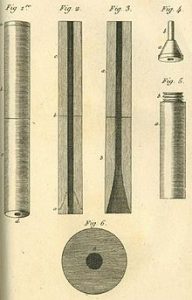 things like Tuberculosis can kill…he lived that nightmare with his mom. I am fairly certain that there were probably issues with her diagnosis too. After studying medicine, Laennec became a doctor. He also became a lecturer at the Collège de France in 1822 and professor of medicine in 1823. His final appointments were that of head of the medical clinic at the Hôpital de la Charité and professor at the Collège de France.
things like Tuberculosis can kill…he lived that nightmare with his mom. I am fairly certain that there were probably issues with her diagnosis too. After studying medicine, Laennec became a doctor. He also became a lecturer at the Collège de France in 1822 and professor of medicine in 1823. His final appointments were that of head of the medical clinic at the Hôpital de la Charité and professor at the Collège de France.
Laennec’s father was a lawyer, and he thought that being a doctor was a waste of René’s talents. With his father’s discouragement, René had a period of time during which he took long walks in the country, danced, studied Greek and wrote poetry. However, in 1799 he returned to study. Laennec studied medicine at the University of Paris under several famous physicians, including Dupuytren and Jean-Nicolas Corvisart-Desmarets. There he was trained to use sound as a diagnostic aid. Corvisart advocated the re-introduction of percussion during the French Revolution. In 1816, he was consulted by a young woman laboring under general symptoms of diseased heart, and in whose case percussion and the application of the hand were of little avail on account of the great degree of fatness. “The other method just mentioned [direct auscultation] being rendered inadmissible by the age and sex of the patient, I happened to recollect a simple and well-known fact, in acoustics…the great distinctness with which we hear the scratch of a pin at one end of a piece of wood on 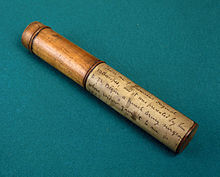 applying our ear to the other. Immediately, on this suggestion, I rolled a quire of paper into a kind of cylinder and applied one end of it to the region of the heart and the other to my ear, and was not a little surprised and pleased to find that I could thereby perceive the action of the heart in a manner much more clear and distinct than I had ever been able to do by the immediate application of my ear.” This situation started Laennec’s mind whirling, and before long, he had developed a simplistic version of what we now are all very familiar…the stethoscope. Ironically, like his mother, Laennec died of Tuberculosis on August 13, 1826. While I’m sure medicine had vastly improved during his lifetime, there was still no significant help for Tuberculosis.
applying our ear to the other. Immediately, on this suggestion, I rolled a quire of paper into a kind of cylinder and applied one end of it to the region of the heart and the other to my ear, and was not a little surprised and pleased to find that I could thereby perceive the action of the heart in a manner much more clear and distinct than I had ever been able to do by the immediate application of my ear.” This situation started Laennec’s mind whirling, and before long, he had developed a simplistic version of what we now are all very familiar…the stethoscope. Ironically, like his mother, Laennec died of Tuberculosis on August 13, 1826. While I’m sure medicine had vastly improved during his lifetime, there was still no significant help for Tuberculosis.
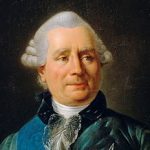
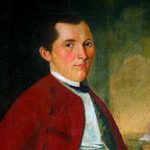 During the years of growing pains for the United States, it was not considered a nation with any power, or in fact, a nation at all. The British wanted to keep he American Colonies under its power for tax purposes, and for the power that comes when a nation owns large areas of land around the globe. The young country…still under the bonds of British rule, was rebelling against what they considered tyranny, however, they would not get very far without military help coming from somewhere. So, on November 29, 1775, the Second Continental Congress, met in Philadelphia, to establish a Committee of Secret Correspondence. The committee’s goal was to provide European nations with a Patriot interpretation of events in Britain’s North American colonies, in the hope of soliciting aid for the American war effort. The committee consisted of Benjamin Franklin, Benjamin Harrison, John Dickinson, John Hay, and Robert Morris. Following the meeting, the committee instructed Silas Deane to meet with French Foreign Minister Charles Gravier, Count de Vergennes, to stress America’s need for military stores and assure the French that the colonies were moving toward “total separation” from Great Britain. Covert French aid began filtering into the colonies soon after the outbreak of hostilities in 1775, but it was not enough. The Americans had to figure out a way to get more aid.
During the years of growing pains for the United States, it was not considered a nation with any power, or in fact, a nation at all. The British wanted to keep he American Colonies under its power for tax purposes, and for the power that comes when a nation owns large areas of land around the globe. The young country…still under the bonds of British rule, was rebelling against what they considered tyranny, however, they would not get very far without military help coming from somewhere. So, on November 29, 1775, the Second Continental Congress, met in Philadelphia, to establish a Committee of Secret Correspondence. The committee’s goal was to provide European nations with a Patriot interpretation of events in Britain’s North American colonies, in the hope of soliciting aid for the American war effort. The committee consisted of Benjamin Franklin, Benjamin Harrison, John Dickinson, John Hay, and Robert Morris. Following the meeting, the committee instructed Silas Deane to meet with French Foreign Minister Charles Gravier, Count de Vergennes, to stress America’s need for military stores and assure the French that the colonies were moving toward “total separation” from Great Britain. Covert French aid began filtering into the colonies soon after the outbreak of hostilities in 1775, but it was not enough. The Americans had to figure out a way to get more aid.
Deane, a Connecticut delegate to the Continental Congress, left for France on the secret mission on March 3, 1776. He managed to negotiate for unofficial assistance from France, in the form of ships containing military supplies, and recruited Gilbert du Motier, the marquis de Lafayette to share his military expertise with the Continental Army’s officer corps. The aid helped some, but America needed a real commitment from France. That was not so easy to obtain, until after the arrival of the charming Benjamin Franklin in France in December 1776. Then, after the American victory at the Battle of Saratoga in October 1777, the French became convinced that it was worth backing the Americans in a formal treaty. On February 6, 1778, the Treaties of Amity and Commerce and Alliance were signed, and in May 1778 the Continental Congress ratified them.
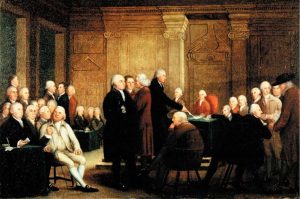
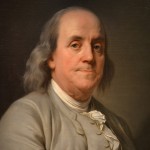 One month later, war between Britain and France formally began when a British squadron fired on two French ships. During the American Revolution, French naval fleets proved critical in the defeat of the British, which was assured after the Battle of Yorktown in October 1781. In reality, this was a spy thriller right out of the likes of James Bond, in that every step of this maneuver was critical to the survival of the United States of America, and everything pretty much went exactly as planned.
One month later, war between Britain and France formally began when a British squadron fired on two French ships. During the American Revolution, French naval fleets proved critical in the defeat of the British, which was assured after the Battle of Yorktown in October 1781. In reality, this was a spy thriller right out of the likes of James Bond, in that every step of this maneuver was critical to the survival of the United States of America, and everything pretty much went exactly as planned.

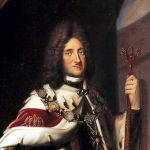 Growing up with the last name of Spencer, I have always been aware that I was related to the Spencers in England, including Princess Diana, her sons and grandchildren, as well as Winston Spencer Churchill. Of course, these relationships were on the Spencer side of my family, but recently, I have been stumbling upon, or in reality, tripping over royalty of the Pattan side of my family, as well as more direct ties to the English throne on the Spencer side of the family.
Growing up with the last name of Spencer, I have always been aware that I was related to the Spencers in England, including Princess Diana, her sons and grandchildren, as well as Winston Spencer Churchill. Of course, these relationships were on the Spencer side of my family, but recently, I have been stumbling upon, or in reality, tripping over royalty of the Pattan side of my family, as well as more direct ties to the English throne on the Spencer side of the family.
When I spoke to my Aunt Sandy Pattan about the king connection of the Pattan side, she said that she knew of Queen Victoria, who I had not found yet, by the way, but she was unaware of the kings in the family line, and was very surprised about where they came from…not the family background, but rather the global locations. The first one to show up was King Charles II of England, who is my 1st cousin 11 times removed. King Charles was actually the king of Scotland from January 30, 1649 to September 3, 1651, and then king of England, Scotland, and Ireland from May 29, 1660 until his death on February 6, 1685 from a stroke.
The next king to show up was King Frederick I of Prussia, who was my 2nd cousin 10 times removed. He was king from January 18, 1701 until his death on February 25, 1713 in Berlin. Next came King Louis XIV of France, who is my 3rd cousin 10 times removed. He was king from May 14, 1643 until his death on September 1, 1715 of gangrene. The next king to show up was King Frederick William II of Prussia, who is my 4th cousin 7 times removed. He was king from August 17, 1786 until his passing on November 16, 1797 in Potsdam, Germany. 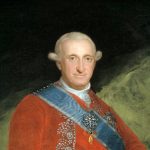

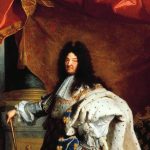 The next king was King Charles IV of Spain, who is my 4th cousin 6 times removed. He was king from December 14, 1788 to March 18, 1808. He did not end his reign upon his death, but rather, riots and popular revolt at the winter palace in Aranjuez, forced him to abdicate to his son, Ferdinand VII. He died on January 20, 1819 in Palazzo Barberini, Rome.
The next king was King Charles IV of Spain, who is my 4th cousin 6 times removed. He was king from December 14, 1788 to March 18, 1808. He did not end his reign upon his death, but rather, riots and popular revolt at the winter palace in Aranjuez, forced him to abdicate to his son, Ferdinand VII. He died on January 20, 1819 in Palazzo Barberini, Rome.
The next king to present himself was King Louis XVI of France, who is of course, related to an earlier king. King Louis XVI is my 4th cousin 6 times removed. He was king of France from May 10, 1774 to September 4, 1792, and oddly King of the French from September 4, 1791 to September 21, 1792. On August 13, 1792, an angry mob tried to kill the queen, thinking that she was too frivolous, but decided to go after the king instead. He tried to flee with his family to Paris, but was captured on August 13, 1792, and imprisoned. His titles were stripped from him on September 21, 1792. He died on January 21, 1793 by execution on the guillotine at just 38 years of age. Finally came Charles VI, Holy Roman Emperor, who is my 4th cousin 9 times removed. He was emperor from October 12, 1711 until his death on October 20, 1740, following a hunting trip on which he consumed a meal of poisonous death cap mushrooms.
I thought that finding out that my mom’s family was related to so many kings, and even an emperor, was 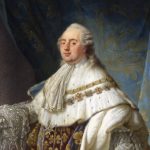
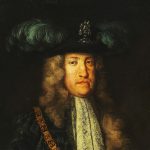 going to be the most shocking thing, but for me, I think the most shocking thing was the way that some of these kings died. It showed me that the times that these kings lived in were not only dangerous in that many of the health issues that are curable now, weren’t back then. But more shocking for me was that fact that kings were sometimes no more safe than anyone else. To accidently eat poison mushrooms would be a horrible death, and I can’t imagine going through that, but to be executed by guillotine is one of the most gruesome things I can think of, and that was not totally uncommon back then.
going to be the most shocking thing, but for me, I think the most shocking thing was the way that some of these kings died. It showed me that the times that these kings lived in were not only dangerous in that many of the health issues that are curable now, weren’t back then. But more shocking for me was that fact that kings were sometimes no more safe than anyone else. To accidently eat poison mushrooms would be a horrible death, and I can’t imagine going through that, but to be executed by guillotine is one of the most gruesome things I can think of, and that was not totally uncommon back then.
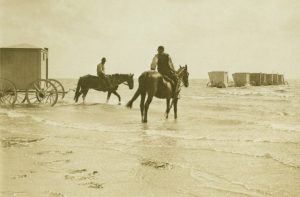 In the 18th and 19th century, going swimming was not done in the same way as it was today. While it was considered ok to swim, the clothing was not considered appropriate, and so men and women were segregated during swimming. I don’t suppose going to the beach was as common, and so it problem might not have come up every day, but it came up enough to create a need for a “proper” way to accomplish an outing involving swimming. Enter the Bathing Machine. The bathing machine was basically a small room built on wheels that could be taken to the beach. People entered the machine while it was on the beach, wearing their street clothing. In the machine they changed into their bathing suit, although men were allowed to bathe nude until the 1860s. They then placed their street clothes into a raised compartment in the bathing machine, where they would remain safe and dry.
In the 18th and 19th century, going swimming was not done in the same way as it was today. While it was considered ok to swim, the clothing was not considered appropriate, and so men and women were segregated during swimming. I don’t suppose going to the beach was as common, and so it problem might not have come up every day, but it came up enough to create a need for a “proper” way to accomplish an outing involving swimming. Enter the Bathing Machine. The bathing machine was basically a small room built on wheels that could be taken to the beach. People entered the machine while it was on the beach, wearing their street clothing. In the machine they changed into their bathing suit, although men were allowed to bathe nude until the 1860s. They then placed their street clothes into a raised compartment in the bathing machine, where they would remain safe and dry.
I believe that all bathing machines had small windows, but one writer in the Manchester Guardian of May 26, 1906 considered them “ill-lighted” and wondered why bathing machines were not improved with a skylight. Once the person had changed, the machine would be wheeled or slid into the water. The most common type of these machines had large wide wheels and were pulled in and out of the surf by a horse or a pair of horses with a driver, but there were some that were pushed in and out of the water by human power. Some resorts had wooden rails into the water for the wheels to roll on, and a few had bathing machines pulled in and out by cables propelled by a steam engine.
Once the machine was in the water, the occupants stepped out from the sea side, and proceeded down steps into the water. Many of the machines had doors front and back, but those with only one door would be backed into the sea or need to be turned around. The most essential element of the machines, was that it blocked any view of the bather from the shore. Some of the more luxurious machines were equipped with a canvas tent lowered from the seaside door, sometimes capable of being lowered to the water, giving the bather greater privacy. Bathing machines would often be equipped with a small flag which could be raised by the bather as a signal to the driver that they were ready to return to shore. Some resorts even employed a dipper, a strong 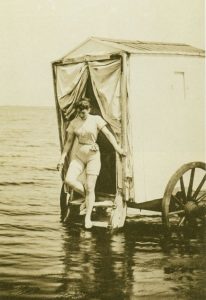 person of the same sex who would assist the bather in and out of the sea. Some dippers were said to push bathers into the water, then yank them out, considered part of the experience. Wow!! I’m not sure I would like that much, but then, to me this whole process seems like it would make the idea of bathing a bit too much of an undertaking, not to mention the added cost to go swimming, because I don’t think anyone would operate a bathing machine for free.
person of the same sex who would assist the bather in and out of the sea. Some dippers were said to push bathers into the water, then yank them out, considered part of the experience. Wow!! I’m not sure I would like that much, but then, to me this whole process seems like it would make the idea of bathing a bit too much of an undertaking, not to mention the added cost to go swimming, because I don’t think anyone would operate a bathing machine for free.
Bathing machines were most commonly used in the United Kingdom and parts of the British Empire with a British population, but were also used in France, Germany, the United States, Mexico, and other nations. Legal segregation of bathing areas in Britain ended in 1901, and the bathing machine declined rapidly. By the start of the 1920s, bathing machines were almost extinct, even on beaches catering to an older clientele. For those of us who grew up in the modern era, this process would seem like a bit of insanity, but then that was simply a different time.

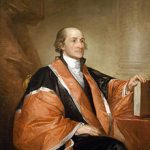 After the Revolutionary War, and the United States independence that followed, the relationship between the two nations was quite strained. The United States did not like having British military posts on our northern and western borders, and Britain’s violation of American neutrality in 1794 when the Royal Navy seized American ships in the West Indies during England’s war with France. Finally, in an attempt to smooth things over, Supreme Court Chief Justice John Jay, who was appointed by President Washington, came up with a treaty. The treaty officially known as the “Treaty of Amity Commerce and Navigation, between His Britannic Majesty; and The United States of America” was signed by Britain’s King George III on November 19, 1794 in London. However, after Jay returned home with news of the treaty’s signing, President Washington, who was now in his second term, had encountered fierce Congressional opposition to the treaty. By 1795, its ratification was still uncertain, and there was work to be done to change things.
After the Revolutionary War, and the United States independence that followed, the relationship between the two nations was quite strained. The United States did not like having British military posts on our northern and western borders, and Britain’s violation of American neutrality in 1794 when the Royal Navy seized American ships in the West Indies during England’s war with France. Finally, in an attempt to smooth things over, Supreme Court Chief Justice John Jay, who was appointed by President Washington, came up with a treaty. The treaty officially known as the “Treaty of Amity Commerce and Navigation, between His Britannic Majesty; and The United States of America” was signed by Britain’s King George III on November 19, 1794 in London. However, after Jay returned home with news of the treaty’s signing, President Washington, who was now in his second term, had encountered fierce Congressional opposition to the treaty. By 1795, its ratification was still uncertain, and there was work to be done to change things.
The two biggest opponents to the treaty were two future presidents…Thomas Jefferson and James Madison. Jefferson was, at the time, in between political positions. He had just completed a term as Washington’s secretary of state from 1789 to 1793 and had not yet become John Adams’ vice president. Fellow Virginian, James Madison was a member of the House of Representatives. Jefferson, Madison and other opponents feared the treaty gave too many concessions to the British. They argued that Jay’s negotiations actually weakened American trade rights and complained that it committed the United States to paying pre-revolutionary debts to English merchants. Washington himself was not completely satisfied with the treaty, but considered preventing another war with America’s former colonial master a priority.
The treaty was finally approved by Congress on August 14, 1795, with exactly the two-thirds majority it needed 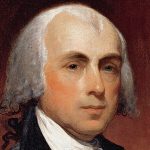
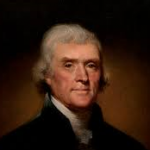 to pass. President Washington signed the treaty just four days later, on August 18, 1795. Washington and Jay may have won the legislative battle and averted war temporarily, but it created a conflict at home that highlighted a deepening division between those of different political ideologies in Washington DC, much like what we see these days. Jefferson and Madison mistrusted Washington’s attachment to maintaining friendly relations with England over revolutionary France, who would have welcomed the United States as a partner in an expanded war against England.
to pass. President Washington signed the treaty just four days later, on August 18, 1795. Washington and Jay may have won the legislative battle and averted war temporarily, but it created a conflict at home that highlighted a deepening division between those of different political ideologies in Washington DC, much like what we see these days. Jefferson and Madison mistrusted Washington’s attachment to maintaining friendly relations with England over revolutionary France, who would have welcomed the United States as a partner in an expanded war against England.
 World wars are a complicated matter. There are multiple enemies, multiple allies, and the lines are not necessarily very clear. The one thing that always seems to be a constant, however, is territory. Imperialism…when a country takes over new lands or countries and makes them subject to their rule, played a big roll in World War I, as did industrialism. By 1900, any territorial gain by one power meant the loss of territory by another, and for Britain, the strongest of all the empires, that was a problem. Britain’s colonial territory was over 100 times the size of its own territory at home, thus giving rise to the phrase “the sun never sets on the British empire.” At this same time, France had control of large areas of Africa. With the rise of industrialism countries needed new markets. The amount of lands owned by Britain and France increased the rivalry with Germany who had entered the scramble to acquire colonies late and only had small areas of Africa.
World wars are a complicated matter. There are multiple enemies, multiple allies, and the lines are not necessarily very clear. The one thing that always seems to be a constant, however, is territory. Imperialism…when a country takes over new lands or countries and makes them subject to their rule, played a big roll in World War I, as did industrialism. By 1900, any territorial gain by one power meant the loss of territory by another, and for Britain, the strongest of all the empires, that was a problem. Britain’s colonial territory was over 100 times the size of its own territory at home, thus giving rise to the phrase “the sun never sets on the British empire.” At this same time, France had control of large areas of Africa. With the rise of industrialism countries needed new markets. The amount of lands owned by Britain and France increased the rivalry with Germany who had entered the scramble to acquire colonies late and only had small areas of Africa.
During this time Germany became concerned that Russia might try to take over their nation, so they signed a  treaty with Austria-Hungary to protect each other from Russia. The Dual Alliance was created by treaty on October 7, 1879 as part of Bismarck’s system of alliances to prevent or limit war. The two powers promised each other support in case of attack by Russia. Also, each state promised benevolent neutrality to the other if one of them was attacked by another European power, most likely France. Germany’s Otto von Bismarck saw the alliance as a way to prevent the isolation of Germany and to preserve peace, as Russia would not wage war against both empires. Then in 1881, Austria-Hungary made an alliance with Serbia to stop Russia from gaining control of Serbia. Before long alliances were popping up everywhere. Germany and Austria-Hungary made an alliance with Italy in 1882 that was dubbed The Triple Alliance to stop Italy from taking sides with Russia. Then in 1894, Russia formed an alliance with France called the Franco-Russian Alliance, to protect Russia against Germany and Austria-Hungary.
treaty with Austria-Hungary to protect each other from Russia. The Dual Alliance was created by treaty on October 7, 1879 as part of Bismarck’s system of alliances to prevent or limit war. The two powers promised each other support in case of attack by Russia. Also, each state promised benevolent neutrality to the other if one of them was attacked by another European power, most likely France. Germany’s Otto von Bismarck saw the alliance as a way to prevent the isolation of Germany and to preserve peace, as Russia would not wage war against both empires. Then in 1881, Austria-Hungary made an alliance with Serbia to stop Russia from gaining control of Serbia. Before long alliances were popping up everywhere. Germany and Austria-Hungary made an alliance with Italy in 1882 that was dubbed The Triple Alliance to stop Italy from taking sides with Russia. Then in 1894, Russia formed an alliance with France called the Franco-Russian Alliance, to protect Russia against Germany and Austria-Hungary.
Now at this point, I’m sure you feel as confused about all this as I did. To me, it seems like it would be very difficult to know who the enemy really was, and even if you knew, it was subject to change, depending on who they formed an alliance with. That is also why I was wondering why on June 16, 1918, the Battle of the Piave River was raging on the Italian front. Russia had bowed out of the war effort in early 1918, and Germany began  to pressure its ally, Austria-Hungary, to devote more resources to combating Italy. Wait…I thought Italy was their ally…apparently not so much. Specifically, the Germans wanted a major new offensive along the Piave River, located just a few kilometers from such important Italian urban centers as Venice, Padua and Verona. In addition to striking on the heels of Russia’s withdrawal, the offensive was intended as a follow-up to the spectacular success of the German-aided operations at Caporetto in the autumn of 1917. Wars really seem to be quite senseless, but when Imperialistic nations try to expand their territories, I guess, alliances can be made and broken quite easily.
to pressure its ally, Austria-Hungary, to devote more resources to combating Italy. Wait…I thought Italy was their ally…apparently not so much. Specifically, the Germans wanted a major new offensive along the Piave River, located just a few kilometers from such important Italian urban centers as Venice, Padua and Verona. In addition to striking on the heels of Russia’s withdrawal, the offensive was intended as a follow-up to the spectacular success of the German-aided operations at Caporetto in the autumn of 1917. Wars really seem to be quite senseless, but when Imperialistic nations try to expand their territories, I guess, alliances can be made and broken quite easily.

